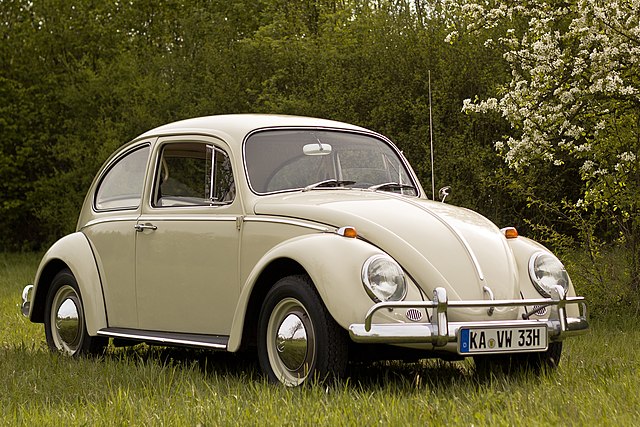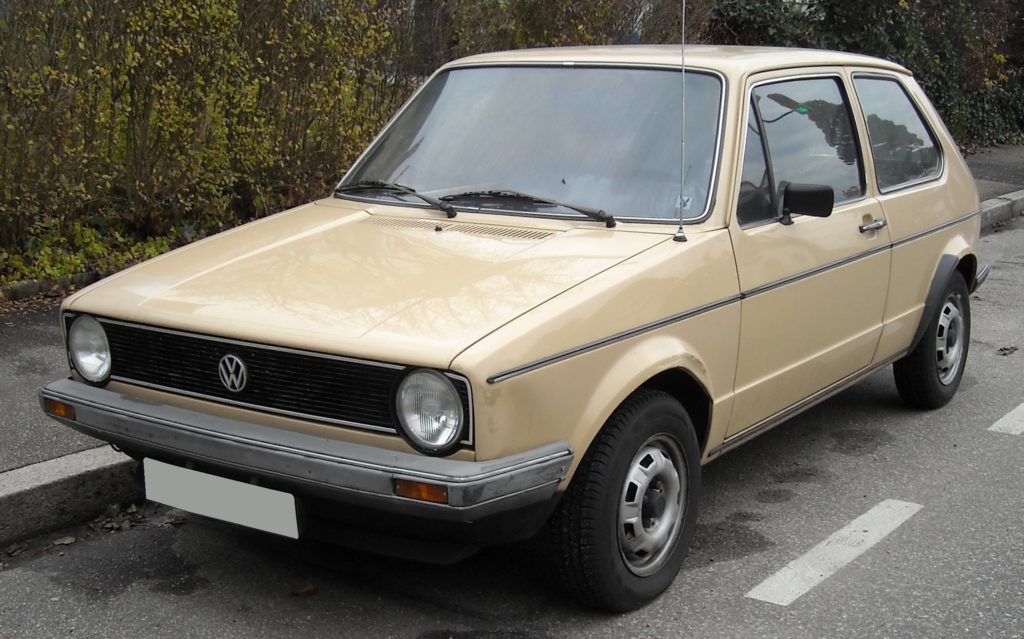Can you remember a time when there wasn’t a Volkswagen Golf? For many people, the answer will be no: the enduring German hatchback has been part of our motoring landscape for almost five decades. And for some, it’s a car to get all misty-eyed about. Because for the millions who owned a Golf as a first or second car, it’s more than four wheels and an engine – it’s a link to their personal history.
In this two-part article, we’ll be looking at the evolution of this motoring icon.
Why did Volkswagen need the Golf?

By Vwexport1300 – Own work, CC BY-SA 3.0,
In the late 1960s, Volkswagen had a world-beating small family car. The VW Beetle — designed by Ferdinand Porsche at Hitler’s behest — had become a global smash hit. In the US, it was adopted as a symbol of the counter-culture, a radical alternative to gas-guzzling Oldsmobiles and Pontiacs. By 1972, Volkswagen had produced over 15 million Beetles.
Yet by the start of the 1970s, the writing on the wall was already there for the iconic bug. Sales had started declining in the late 60s, as new competitors ate into VW’s pie. In North America, the early seventies saw Datsun, Toyota and Honda start to dominate the small vehicle market. In Europe, the Beetle lost ground to the Fiat 127, Renault 5 and Ford Escort — among others. VW tried to adapt the Beetle to meet stiffer pollution controls and the need for better performance, but only succeeded in reducing its reliability and economy.
To revive Volkswagen’s flagging fortunes, a replacement was needed. And it needed to be massively popular.
Enter Giorgetto Giugiaro

By Mitjagodnic – Own work, CC BY-SA 4.0
Niels van Roij has penned a great piece on the design of the Mk 1 Golf, which you should definitely check out, but here’s the short version.
As early as 1969, the Volkswagen suits took a trip to the Turin Auto Salon, and spotted that four of their favourite designs had been drafted by a young company Italdesign, founded by Giorgetto Giurgiaro. The following year, he was headed to Wolfsburg to design the new Golf.
The replacement for the Beetle couldn’t have been more different. Gone were the flowing organic curves, replaced by a crisp sharp-edged aesthetic, with a bold C pillar.
In his article, Niels comments that Italdesign used the same design principles for the Lotus Esprit, BMW M1, DeLorean DMC-12 and Maserati Quattroporte… one of those things that once it’s been pointed out, you wonder why you’d never noticed it before.
As a reward for his work, Giurgiaro received a rather special Golf GTI: before five-door GTIs existed, VW built him one so he could use it with his family.
The Mk1 hits the mark

Rudolf Stricker, Attribution, via Wikimedia Commons
Above, we noted that Volkswagen needed a success with its new models. In actual fact, the company was in a dire situation. As Wikipedia tells us:
Rudolf Leiding replaced Lotz as Director General of Volkswagen from 1971 to 1975. Commenting on the situation at Volkswagen as he found it, Leiding said: “The global situation for VW was more critical than we had once thought – to put it simply, we were dealing with the survival of a giant group, which employed more than 220,000 people worldwide …”
There must have been some white knuckles in German boardrooms when the Golf went on sale in May 1975. And then some wild teutonic parties shortly after, as Golfs sold like hot cakes at a hot cake enthusiasts’ convention. By October 1976, VW had produced its millionth Golf.
The Golf topped the charts in West Germany over most of its production cycle, but export markets were also critical. In the USA — where for some reason, it was named the Rabbit — 98,215 were sold in 1975, growing to almost 215,000 units in 1979. Other important markets were Mexico (branded as the Caribe) and South Africa (where the CitiGolf variant was sold from 1984 to 2009). The reception in the UK was initially a bit tepid: 19,000 cars were sold, but that only got the Golf 14th spot in the UK’s 1975’s car sales.
In 1976, Volkswagen launched another icon — the Golf GTI. The GTI deserves an article in itself, but for now let’s just note that with its release, Volkswagen had practically invented the hot hatch.
In 1983, the Mk1 was superceded by the roomier Mk2. By then, sales of the Mk 1 had reached 6.99 million units. 462,000 of those were the Golf GTI.
Almost single-handedly, the Golf had saved Volkswagen and helped to kick off the hatchback revolution.
What was next? Find out in Part Two, coming soon.
The WVS blog covers a wide range of automotive topics, from the contentious to the light-hearted. We are an independent garage specialising in the VW group marques, including Audi, Volkswagen, Skoda and SEAT. WVS provides services, repairs and MOTs, delivering a main dealer level of care at affordable prices. To book your vehicle in, or for any enquiries, get in touch.

